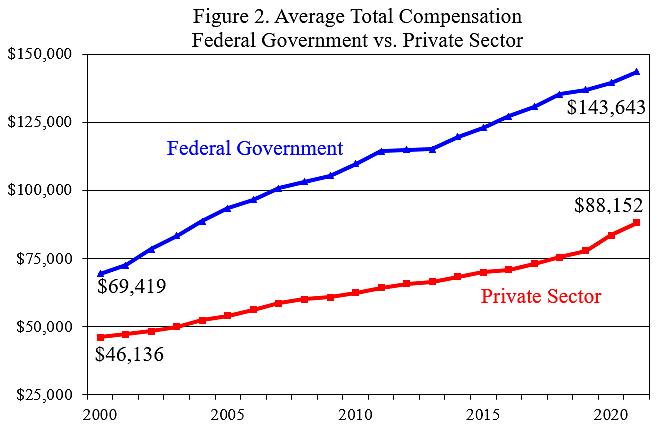New data show that growth in federal worker pay lagged growth in private-sector pay in recent years. The average federal worker still makes far more than the average private-sector worker in total compensation, but the advantage has narrowed. From the taxpayer perspective, the moderation in federal worker costs is good news.
Figure 1 shows average wages for the U.S. private sector and for the federal government’s 2.2 million civilian workers. Federal pay growth outpaced private pay growth for the decade up until 2011 when a three-year soft wage freeze kicked in. After that, federal wages resumed strong growth until 2018. The data is from the Bureau of Economic Analysis national income accounts, Table 6.6D.
Then in 2020 and 2021, federal pay growth slowed and private pay soared, as shown in the figure. Average federal wages rose 1.8 percent in 2020 and 2.3 percent in 2021, while average private-sector wages increased 7.7 percent in 2020 and 5.9 percent in 2021.
The consumer price index increased 1.2 percent in 2020 and 4.7 percent in 2021. Thus, real federal wages rose in 2020 and fell in 2021, while real private wages soared in 2020 and rose slightly in 2021. Now in 2022, inflation is soaring and pushing down real wages for most workers across the economy.
Here are some observations on the pay data:
- Private pay is set in markets, and high worker demand in recent years has pushed pay upwards. By contrast, federal pay is set by politics and is less responsive to changing economic conditions.
- Some reporters worry about a worker exodus from the public sector, but I don’t think that will be a major problem in the federal government. The voluntary quit rate in the federal government is still only one-quarter as high as in the private sector, which suggests that federal workers are satisfied with their compensation packages.
- One reason workers favor federal employment is that the benefits are more lucrative than in the private sector. The BEA data show that the average value of benefits in the federal workforce was $44,021 in 2021, far higher than the $13,486 of average benefits in the private workforce. Figure 2 below shows the BEA data (from Table 6.2D) for total compensation (wages plus benefits).
- Another advantage of federal employment is the high job security. Federal workers are laid off at just one-quarter the rate of private-sector workers. Job security could be a valuable benefit in coming months if the economy enters a major recession.


